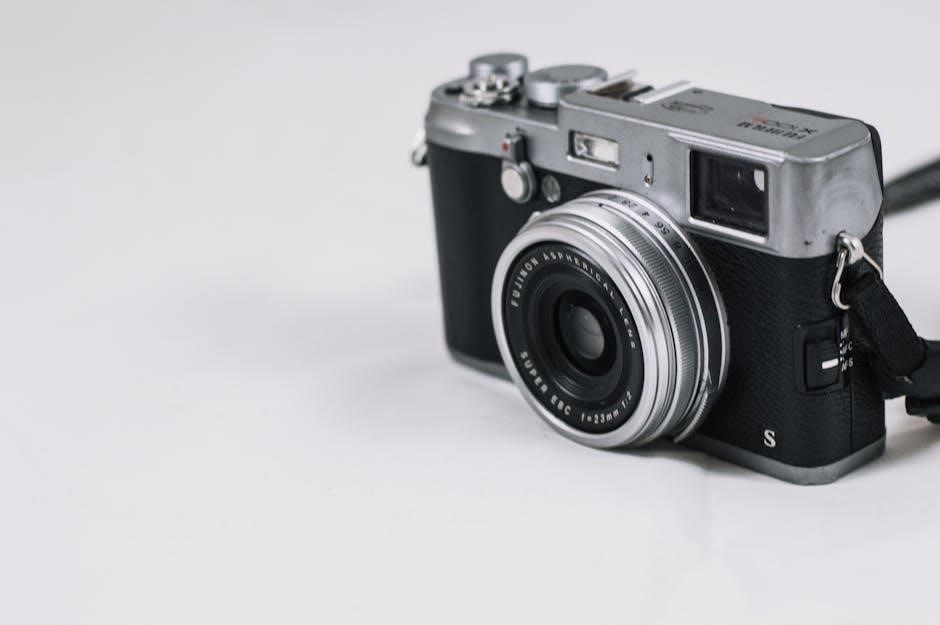
rebel xt manual
Overview of the Canon EOS Digital Rebel XT
The Canon EOS Digital Rebel XT, also known as the EOS 350D, is a digital SLR camera renowned for its versatility and performance. Released in 2005, it offers various shooting modes, including automatic and manual, catering to both beginners and experienced photographers seeking a compact, capable DSLR.
Finding and Downloading the Instruction Manual
To locate the Canon EOS Digital Rebel XT instruction manual, visit Canon’s support website. Search for the camera model and navigate to the “Manuals” section. Download the PDF file, ensuring you have a PDF reader installed to access the comprehensive guide for your camera.
Downloading from Canon’s Website
Obtaining the instruction manual for your Canon EOS Digital Rebel XT from Canon’s official website is a straightforward process. Begin by navigating to the “Support” section of the Canon website. Use the search bar to enter “EOS Digital Rebel XT” or “EOS 350D” to find the specific product page for your camera.
Once on the product page, locate the “Manuals” or “Downloads” tab. Here, you will find a list of available resources, including the instruction manual. Look for the manual specifically labeled as the “Instruction Manual” or “User Guide,” typically available in PDF format.
Click on the link to initiate the download. You may be prompted to agree to Canon’s terms and conditions before proceeding. Save the PDF file to a convenient location on your computer or device. Ensure you have a PDF reader installed, such as Adobe Acrobat Reader, to open and view the manual.
Downloading directly from Canon ensures you receive the most accurate and up-to-date version of the manual, providing comprehensive guidance on using your EOS Digital Rebel XT.
PDF Manual Contents
The PDF manual for the Canon EOS Digital Rebel XT is a comprehensive guide, meticulously structured to provide users with a complete understanding of the camera’s features and functionalities. Upon opening the PDF, you’ll typically find a detailed table of contents, allowing for easy navigation to specific sections of interest.
The manual begins with essential information on camera setup, including inserting the battery and memory card, and initial settings like date and time. Subsequent sections delve into the camera’s various shooting modes, such as Auto, Program, Aperture Priority, Shutter Priority, and Manual, explaining how to utilize each mode effectively.
Exposure settings, including ISO, aperture, and shutter speed, are thoroughly covered, along with guidance on achieving optimal image quality in different lighting conditions. The manual also dedicates sections to autofocus modes, manual focus techniques, and image playback options. Furthermore, you’ll find information on customizing camera settings, troubleshooting common issues, and maintaining the camera’s sensor.
Detailed diagrams and illustrations accompany the text, enhancing clarity and comprehension. The PDF manual serves as an indispensable resource for both novice and experienced photographers seeking to maximize the potential of their Canon EOS Digital Rebel XT.
Basic Camera Setup
Setting up your Canon EOS Digital Rebel XT involves inserting the battery and memory card. You will also need to configure initial settings like date, time, and language. This ensures accurate image timestamps and personalized operation from the start.
Setting Date and Time
Configuring the correct date and time on your Canon EOS Digital Rebel XT is essential for accurate photo organization. To begin, press the “Menu” button on the camera’s rear panel. This will bring up the camera’s menu system on the LCD screen. Navigate to the “Set-up” menu, often represented by a wrench icon.
Within the “Set-up” menu, locate the “Date/Time” option. Select this option to access the date and time settings. Use the directional arrow keys to highlight each field (year, month, day, hour, minute) and adjust the values accordingly. Once you have entered the correct date and time, press the “Set” button to confirm your changes.
This ensures that all your photos will be tagged with the correct timestamp. Accurate timestamps are crucial for organizing your photos chronologically, especially when working with large photo libraries. Furthermore, some software applications rely on accurate timestamps for specific features.

Shooting Modes
The Canon EOS Digital Rebel XT offers a range of shooting modes, from fully automatic to manual. These modes allow users to adapt to various shooting conditions, providing control over exposure and creative effects. Explore these for optimal results.
Manual Mode
Manual mode on the Canon EOS Digital Rebel XT grants photographers complete control over exposure settings, opening up a world of creative possibilities. In this mode, you can independently adjust both the aperture and shutter speed to achieve the desired effect. Understanding how these settings interact is crucial for mastering manual photography.
Aperture controls the size of the lens opening, affecting the depth of field and the amount of light entering the camera. Shutter speed determines how long the camera’s sensor is exposed to light, influencing motion blur and overall brightness. By manipulating these settings, you can fine-tune your images to match your artistic vision.
Manual mode is particularly useful in challenging lighting situations or when you want to override the camera’s automatic settings. It allows you to experiment with different combinations of aperture and shutter speed to achieve the perfect exposure and creative effect. With practice, manual mode becomes an indispensable tool for capturing stunning photographs.
Use the camera’s light meter as a guide, but trust your judgment and artistic vision to create unique and compelling images.
Exposure Compensation and AEB
The Canon EOS Digital Rebel XT offers powerful tools for managing exposure, including exposure compensation and Auto Exposure Bracketing (AEB). These features allow you to fine-tune the brightness of your images and ensure you capture the perfect shot, even in challenging lighting conditions.
Exposure compensation lets you override the camera’s automatic exposure settings, either brightening or darkening the image. This is useful when the camera’s meter is fooled by bright or dark subjects, resulting in under- or overexposed photos. By adjusting the exposure compensation, you can achieve a more balanced and accurate exposure.
AEB takes this concept a step further by automatically capturing three images in rapid succession: one at the metered exposure, one underexposed, and one overexposed. This gives you a range of options to choose from, ensuring you capture the best possible exposure. AEB is particularly helpful in high-contrast scenes where it’s difficult to determine the optimal exposure.
Both exposure compensation and AEB are essential tools for any photographer looking to take control of their images and achieve professional-looking results.

Manual Focus
The Canon EOS Digital Rebel XT allows for precise control over focusing with its manual focus (MF) option. This is particularly useful in situations where autofocus struggles, such as low-light conditions, macro photography, or when shooting through obstructions. Mastering manual focus expands your creative possibilities and ensures sharp images in challenging scenarios.
To engage manual focus, locate the focus mode switch on your lens and slide it to the “MF” position. This disengages the autofocus system, giving you direct control over the lens’s focusing elements. Next, use the focusing ring on the lens to adjust the sharpness of the image. As you rotate the ring, observe the subject in your viewfinder or on the LCD screen. The goal is to achieve the clearest and most detailed image possible.
For critical focus, especially in macro or portrait photography, consider using the camera’s Live View mode (if available) and zooming in on the subject to fine-tune the focus. This allows you to see minute details and ensure the sharpest possible result. Practice and patience are key to mastering manual focus, but the results are well worth the effort.

Software Guide and Installation
The Canon EOS Digital Rebel XT comes bundled with a suite of software designed to enhance your photography workflow. This software allows you to transfer images, edit photos, and manage your camera settings directly from your computer. Understanding the software and its installation process is crucial for maximizing your camera’s potential.
Typically, the software suite includes Canon’s Digital Photo Professional (DPP) for image editing and RAW processing, EOS Utility for camera control and image transfer, and ZoomBrowser EX for image organization. To install the software, insert the provided CD-ROM into your computer’s drive. The installation process should begin automatically. If it doesn’t, navigate to the CD-ROM in your file explorer and run the setup file.
Follow the on-screen instructions to complete the installation. You may be prompted to connect your camera to the computer via USB. Ensure your camera is turned on and in the correct mode for connection (usually indicated in the camera’s menu). Once installed, explore each program to familiarize yourself with its features and capabilities. The software guide, often available as a PDF on the CD-ROM, provides detailed instructions and tips for using each application effectively, making your photo editing experience more intuitive and efficient.
Troubleshooting Common Issues
Even with proper care, the Canon EOS Digital Rebel XT may encounter occasional issues. A common problem is the camera failing to turn on, often due to a depleted or improperly installed battery. Ensure the battery is fully charged and correctly inserted. If the issue persists, try cleaning the battery contacts.
Another frequent concern is image quality problems, such as blurry photos. This can be due to incorrect focus or camera shake. Use proper focusing techniques and consider using a tripod in low-light situations. Error messages on the LCD screen can also be perplexing. Consult the instruction manual to decipher the error code and follow the recommended solutions.
If the camera freezes or becomes unresponsive, try removing and reinserting the battery to reset it. For issues with image transfer, check the USB connection and ensure the correct software is installed. If problems persist, consult the Canon support website for troubleshooting guides, updated drivers, and FAQs. Addressing these common issues promptly will help maintain your camera’s performance and extend its lifespan, ensuring you capture stunning photos for years to come.
Cleaning the CMOS Sensor
Dust and debris can accumulate on the CMOS sensor of your Canon EOS Digital Rebel XT, leading to spots or imperfections in your images. Cleaning the sensor is crucial for maintaining image quality. Before you begin, ensure the battery is fully charged to avoid interruptions during the cleaning process.
First, use the camera’s built-in sensor cleaning function found in the menu. This may dislodge some of the dust. If this doesn’t suffice, you can manually clean the sensor. In a clean, well-lit environment, lock up the mirror using the manual’s instructions. Use a blower to gently remove loose particles.
For stubborn spots, you may need to use sensor swabs and cleaning solution designed specifically for camera sensors. Follow the product instructions carefully and gently swipe the swab across the sensor in one direction. Avoid applying too much pressure. After cleaning, inspect the sensor for any remaining spots. If necessary, repeat the process with a fresh swab. Regular sensor cleaning will help ensure your photos remain pristine and free from distracting artifacts, preserving the clarity and detail of your images.
Battery Information and Life
The Canon EOS Digital Rebel XT utilizes the NB-2LH battery pack as its power source. Understanding battery information and maximizing battery life is essential for uninterrupted shooting sessions. The NB-2LH is a rechargeable lithium-ion battery, known for its lightweight design and consistent power output. A fully charged battery can provide approximately 400 shots, but this number can vary depending on usage conditions.
Factors such as frequent use of the LCD screen, flash, and image stabilization can significantly reduce battery life. To extend your shooting time, minimize these power-intensive features when possible. Carrying a spare NB-2LH battery ensures you won’t miss important moments due to a depleted power source. The battery’s performance can also degrade over time with repeated charging and discharging cycles.
Proper storage is crucial to maintaining battery health. Avoid extreme temperatures and humidity when storing the battery. Before extended periods of non-use, partially charge the battery to around 40-50% to prevent deep discharge. By following these guidelines, you can optimize the battery’s performance and longevity, ensuring reliable power for your Canon EOS Digital Rebel XT.

Available Accessories
Enhance your Canon EOS Digital Rebel XT experience with a variety of accessories designed to expand its capabilities and improve your photography. Several lens options were available, including the standard kit lens and various prime and zoom lenses to suit different shooting scenarios. External flash units, such as the Speedlite series, provide more powerful and versatile lighting options than the built-in flash.
Consider investing in a remote shutter release for minimizing camera shake during long exposures or self-portraits. Extra battery packs, like the NB-2LH, ensure you won’t run out of power during extended shoots. A dedicated battery grip can also extend battery life and provide a more comfortable grip, especially for vertical shooting.
Memory cards, such as CompactFlash (CF) cards, are essential for storing your photos. Choose a card with sufficient capacity and speed for your needs. A camera bag or case protects your Rebel XT from dust, scratches, and impacts. Finally, various filters, such as UV, polarizing, and neutral density filters, can enhance your images in different lighting conditions. These accessories can significantly improve your photography with the Canon EOS Digital Rebel XT.
Specifications of the EOS Digital Rebel XT
The Canon EOS Digital Rebel XT boasts a range of impressive specifications for its time. It features an 8.0-megapixel CMOS sensor, capturing detailed images with good dynamic range. The camera uses a DIGIC II image processor, enabling fast processing speeds and responsive performance. The ISO range extends from 100 to 1600, allowing for shooting in various lighting conditions.
The Rebel XT has a 7-point autofocus system for accurate and reliable focusing. It offers a shutter speed range of 30 seconds to 1/4000th of a second, providing creative control over exposure. The camera can shoot continuously at approximately 3 frames per second. It uses CompactFlash (CF) cards for storage and has a 1.8-inch LCD screen for image review.
The Rebel XT also supports various shooting modes, including manual, aperture priority, shutter priority, and program modes. It features built-in flash and supports external flash units. The camera is powered by an NB-2LH battery pack. Its compact and lightweight design makes it a portable and versatile option for photographers. These specifications combined make it a popular choice.